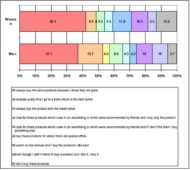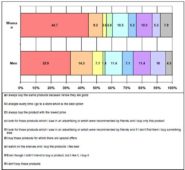The influence of advertising and friends is approximately the same in the case of men and it is higher in the case of women. Despite this, the flexibility is higher both for women and men in the case of non alcoholic products. So 12.8% of the men are influenced by friends and advertising and 14.4% of the women do so, but 10,5% of the women and 11,4% of the men would buy something else in the case that they don’t buy the needed products. In the case of alcoholic products, the emotional behavior is more frequent at women than at men. 10.5% of the women and 11.4% of the men watch on the shelves and they buy the product they like best. 5.3% of the women and 10% of the men buy products if they like them, although they didn’t have this intention initially. This shows that the way, how a product looks and the way the products are arranged on the shelves can influence the decision of the consumer. For this reason companies should analyze the aspects which attract more at a product. 7.9% of the women and 4.3% of the men don’t buy this type of products. Both percentages are lower than in the case of non-alcoholic beverages, which show that alcoholic products are bought more often than non-alcoholic ones.
Conclusion
The analysis of the consumer behavior gives companies precious information about the way they should design their marketing strategy. In the case of alcoholic and non-alcoholic beverages there is a mixed consumer behavior, which indicates a mixture of the marketing instruments. As observed in the article, the experienced based behavior is preponderant in both cases and both for women and for men. This shows the fact that the buying decision is often taken before the buying process and relies very often on the previous experiences. This fact makes it very difficult for new companies to convince the consumer to buy something else, because most of the consumers usually buy the same products, because they like them and because they know it. This type of behavior represents an advantage for the existent companies, but as mentioned, makes it difficult for new comers. Despite this, there is also a big amount of consumers, who are influenced by the advertising or by emotional components in the store. For this reason existent companies should advertise their products in order to keep the interests of the customers, while new comers should try to use these instruments in order to convince the customers to buy the products.
Acknowledgment
This work was supported from the European Social Fund through Sectoral Operational Programme Human Resources Development 2007-2013, project number POSDRU/ 89/ 1.5/ S/ 59184 “Performance and excellence in postdoctoral research in Romanian economics science domain”.
References
Backhaus, K., Erichson, B., Plinke, W. & Weiber, R. (2000). Multivariate Analysemethoden — Eine anwendungsorientierte Einfuehrung, Springer, Berlin.
Publisher – Google Scholar
Balan, C. (2010). ‘Present Shifts in Consumer Complaint Management,’ in: Brătianu C., Lixăndroiu D., Pop N.A., Business Excellence, Proceedings of the 5th International Conference on Business Excellence, Volume I, Informarket Publishing House, Braşov, Romania, pp. 38-41.
Blythe, J. (1998). ‘Comportamentul Consumatorului,’ Teora, Bucuresti.
Google Scholar
Catoiu, I. & Teodorescu, N. (1997). ‘Comportamentul Consumatorului: Teorie si Practica,’ Editura Economica.
Google Scholar
Catoiu, I. & Teodorescu, N. (2003). ‘Comportamnetul Consumatorului,’ Uranus, Bucureşti.
Foscht, T. & Swoboda, B. (2004). Käuferverhalten: Grundlagen — Perspektiven — Anwendungen, Gabler, Wiesbaden.
Publisher – Google Scholar
Istudor, N. & Pelau, C. (2011). ‘Consumer Behavior on the Fruits and Vegetables Market,’ at the international confernec European Integration — New Challenges, Oradea, 27-28 mai 2011, pg. 1759-1764.
Google Scholar
Jimenez-Martin, S. & Ladrón-de-Guevara, A. (2007). “Modeling Consumption Patterns in the Attribute Space: Theory and Evidence of Hybrid Behavior,” in: International Journal of Research in Marketing, nr. 24, pg. 242—253.
Publisher – Google Scholar
Kroeber-Riel, W. & Weinberg P. (2003). ‘Konsumentenverhalten,’ Vahlen, Münchent
Pelau, C. (2011a). ‘Cognitive and Emotional Buying Decision of the Romanian Consumer,’ at the conference „Provocările crizei si răspunsul stiintei economice”, Bucuresti, 1-2 iulie 2011.
Pelau, C. (2011b). ‘Analysis of Consumer Behavior for Different Product Groups,’ in Management & Marketing, vol. 6, special issue/ 2011, pg. 101-114.
Pop, C. M. & Scridon, A. M. (2009). ‘A Multinominal Logit Based Evaluation of Client’s Preferences in the Cluj Napoca Retail Market,’ in: Brătianu C., Lixăndroiu D., Pop N.A., Business Excellence, Proceedings of the 4th International Conference on Business Excellence, Volume II, Informarket Publishing House, Braşov, Romania, pp.106-109.
Pop, N. Al. & Pelau, C. (2007). ‘Knowing the Motivation of Buying,’ in: Analele universităţii din Oradea, seria: Ştiinţe economice, editura Universităţii din Oradea, Tom XVI, 2007, ediţie specială pentru conferinţa internaţională „Integrarea Europeană — Noi provocări pentru economia României“, ediţia 3-a, Oradea, May 2007, pg. 1063-1066.
Google Scholar
Pop, N. Al. & Pelau, C. (2011). ‘Cognitive and Emotional Reactions in the Buying Decision and their Impact on the Success of Tehnological Changes,’ in: Rusu, C.: Proceedings of the 7th International Conference on Management of Technological Changes, Alexandroupolis, Greece, September 2011, pg. 193-196
Pop, N. Al. & Vladoi, A. (2009). ‘Characteristics of the Implementation of a Marketing Approach in the Romanian Companies,’ in: Brătianu C., Lixăndroiu D., Pop N.A., Business Excellence, Proceedings of the 4th International Conference on Business Excellence, Volume II, Informarket Publishing House, Braşov, Romania, pp. 110-113.
Solomon, M., Bamossy, G., Askegaard, S. & Hogg, M. K. (2010). ‘Consumer Behavior — A European Perspective,’ 4th edition, Prentice Hall, Financial Times, Harlow.
Swoboda, B., Berg, B. & Dabija, D.C. (2009). ‘Perception of Retail Marketing — Empirical Study on Formats,’ in Brătianu C., Lixăndroiu D., Pop N.A., Business Excellence, Proceedings of the 4th International Conference on Business Excellence, Volume II, Informarket Publishing House, Braşov, Romania, pp.220-225.




